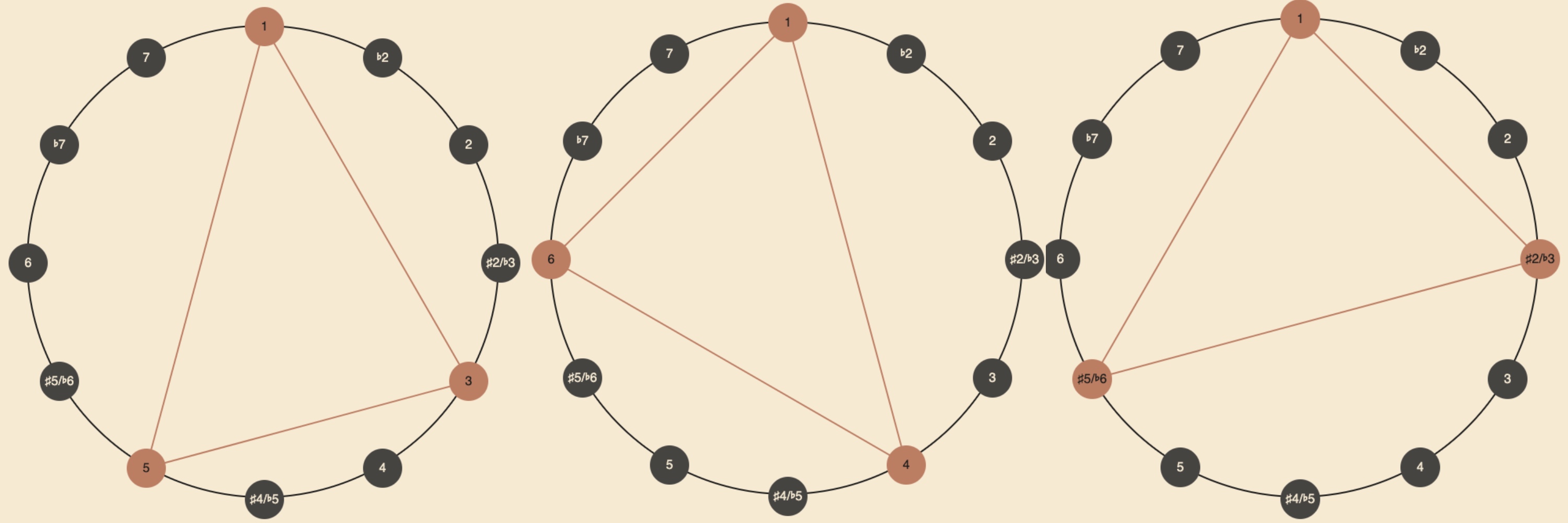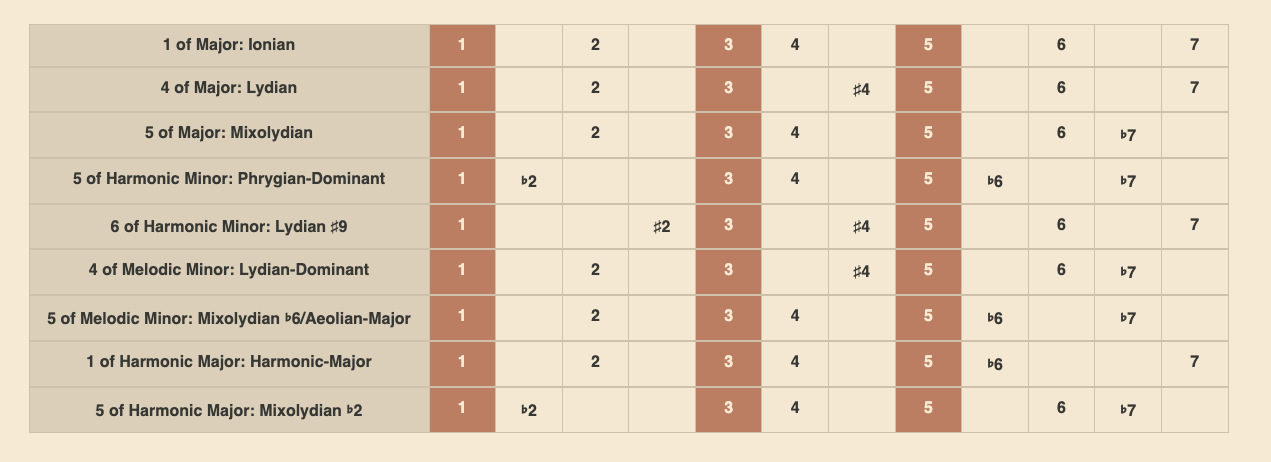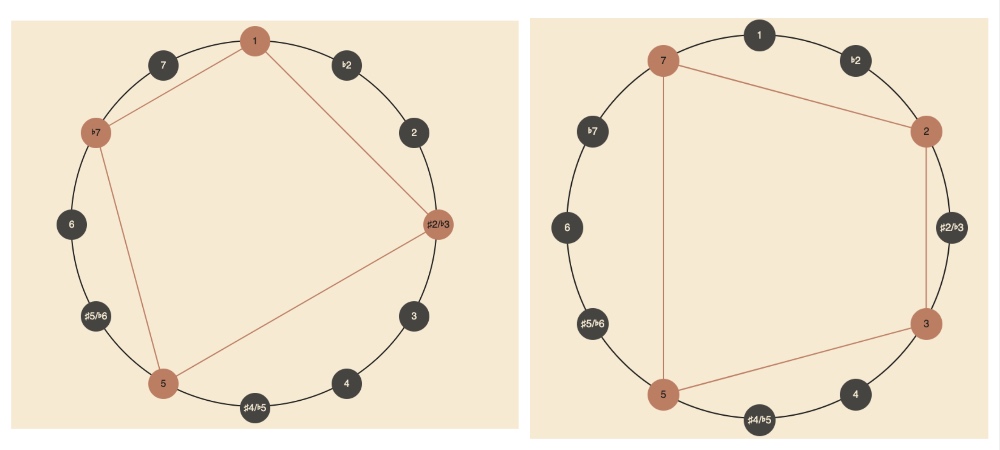中文版请下滑或点击
This English version of instruction is generated by AI:
Need help visualizing scales, modes, or pitch sets? The Pitch Class Clock gives you a hands-on way to experiment with notes. Rotate the clock to see how modes shift, or light up custom pitch collections to compare harmonic colors. The horizontal scale-sheet scrolls through classic and hybrid scales—from major and minor to blues and symmetrical patterns—so you can find inspiration or build your own vocabulary.
How to Use the Pitch Class Clock
Click on a note (degree) on the clock to instantly see which scales contain it. Want to know how many scales include the ♯4 interval? Just click and find out.
By selecting multiple degrees, you can form intervals (lines) or full chords (polygons). This helps you visualize and explore different chord voicings and inversions.
For example, a major triad (1–3–5) can be inverted to forms like 1–4–6 or 1–♭3–♭6, giving you fresh harmonic possibilities at a glance.

See Which Scales Contain Your Selected Pitch Set
Curious which scales include a specific group of notes? Select a pitch set—like a major triad (1–3–5)—and the clock will highlight all the scales that contain it. It’s an easy way to explore compatible scales, chord–scale relationships, and modal options.

Rotate Shapes to Discover Their Functions in Different Contexts
By rotating a polygon (a chord shape), you can see how it behaves when starting on different scale degrees. For example, can you play ♭2–♭3–♯4–6? It might seem unusual, but it’s actually just a minor seventh chord in disguise.

More importantly, this tool helps you understand how a pitch set functions over different chords. For instance, over a major seventh chord, you can play a minor seventh chord starting on the 3rd degree. If you select 1–♭3–5–♭7 on the clock and reinterpret the root of the minor seventh as the 3rd of a major seventh chord, you’ll realize you’re actually playing the 3–5–7–9 of a major seventh—a common and beautiful upper-structure voicing.
Improvisation Ideas
Not sure which scale to use for improvisation? Just click on a scale and look at the chords it contains—you might find the right match instantly.

But be careful: if you see a major seventh chord and immediately jump to using Lydian ♯9, don’t say you learned that here! When using modal scales like these, always consider the composer’s intention and whether the sound truly fits the musical context.
Parallel Structures
When a pitch set appears across multiple modes of the same parent scale, it means you can move that set in parallel within the scale. For guitarists, this often translates to being able to repeat the same fingering shape up or down the fretboard.
Because the internal structure of the pitch set stays the same, your melodic lines retain their internal coherence—even as they shift—creating a sound similar to modal sequences or motivic development.

A classic example is the set 1–♭3–4–♭7. This group of notes exists in four different modes of the major scale, which means you can shift it in parallel four times and still remain entirely within the scale.
级数钟
一个可以互动的级数钟。
这几天忙着用ChatGPT敲代码… 连我这种浑水摸鱼的人都能通过AI设计出一个功能良好的Web应用,可见AI的强大之处。其中也包括了很多折腾反复的情况,具体来说,因为自己对代码的无知。最后我和AI的对话就变成了:这里有问题,应该怎么改?然后复制粘贴,再进行纠错。也见识了什么叫“屎山”,因为移动端的设计必须要重新设计JavaScript代码又加入了新的功能来填补漏洞。不管怎么说,最后反正是运行起来了。
功能
这个级数钟大部分的灵感是汲取于我的老师Noel Johnston的Voicing Mode App。在很多时候我不知道该怎么即兴或者需要一个Reference来源的时候,我都会咨询那个网页APP。现在在那个网页的基础上,这个级数钟有这样一些功能:
- 一个基于Pitch Class的级数钟,在Pitch Class 里,C = 0, 但是这里的级数钟其实是首调概念,所以12点钟方向是以1开始。
- 五条七音Parent Scale, 到目前为止有五条七音主音阶和其下的modes。以及一些非七音的和弦。应该能满足绝大多数的情况。
- 旋转。Transposition。把整个pitch-class转调,可以形象的固定住pitch class的相对音程,并把它放到不同的级数上去。
如何使用
级数与音阶
点击钟表上的级数就可以确定这个级数存在于哪条音阶里,想知道有多少音阶包含♯4 这个音程吗?点一下就知道了。
当点击多个级数后,就可以构成一个线条(音程)或者多边形(和弦)。你也可以通过它来找到不同的转位。
当一个Major: 1-3-5开始转位时,你可以得到1-4-6, 1-♭3-♭6

2. 查看在什么音阶里包含这个pitch set。比如你可以看的Major 三和弦存在于哪些音阶里。

可见三和弦存在于大调1-4-5级上,etc
固定音级
当你旋转多边形的时候,就可以得出它在不同级数的表现。比如:你能弹♭2-♭3-♯4-6吗?它其实只是一个小七和弦罢了。
但更重要的是理解当你在选择一组音列的时候,它在本地的和弦上的构成是什么。比如:在大七和弦上,你可以以3级为根音弹小七和弦。那么在钟上设置1-♭3-5-♭7,这时把小七的根音的音转换成大七的3音,可以得出你实际是弹的大七和弦的3-5-7-2(9)。

1级向右旋转4次可得
反过来想,在属七和弦上弹3-5-7-♭9,把它逆时针旋转到1级,你能得出它到底是什么和弦吗?
即兴素材
不知道即兴用哪条音阶?点击音阶的和弦组成音即可。
大七和弦上除了Ionian和Lydian,还可以用什么音阶?点击即有。

当然如果你见到大七就想用Lydian ♯9,千万别说是我教的。在使用这些modal scale的时候一定要慎重考虑作曲家的意图和是否合适。
平行结构
当一组音列存在于一条主音阶的多个调式当中,就意味这这组音可以在这条音阶上平行移动,对于吉他手来说,这意味着可以保持这个指型弹奏。同样因为音列本身的结构保持着不变,意味着你的旋律线条保持了内在的结构完整,且也获得像模进一样的线条。

最经典的比如1-♭3-4-♭7这组音列,存在于4条音阶上,意味着你可以平行移动4次也还是在一条主音阶里。
我自己还在考虑这个钟的实际用法,还有待我整理出来。
I’d love to hear what you think. Use your GitHub account to leave a comment below! 欢迎用 GitHub 账号在下方留言交流!